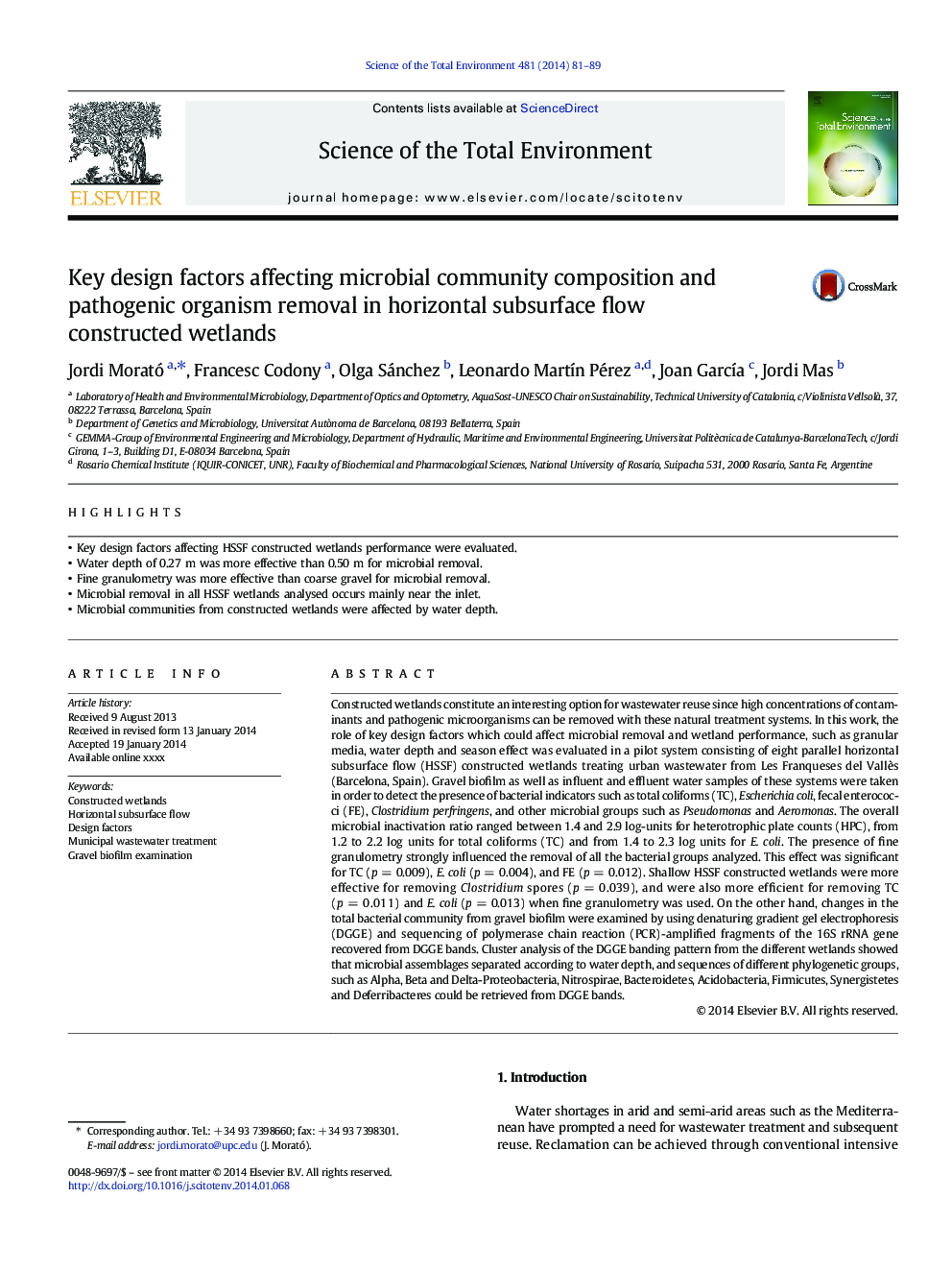| کد مقاله | کد نشریه | سال انتشار | مقاله انگلیسی | نسخه تمام متن |
|---|---|---|---|---|
| 6330834 | 1619786 | 2014 | 9 صفحه PDF | دانلود رایگان |
عنوان انگلیسی مقاله ISI
Key design factors affecting microbial community composition and pathogenic organism removal in horizontal subsurface flow constructed wetlands
ترجمه فارسی عنوان
عوامل طراحی کلیدی موثر بر ترکیب جامعه میکروبی و حذف ارگانیسم های بیماری زا در تالاب افقی زیر سطح افقی
دانلود مقاله + سفارش ترجمه
دانلود مقاله ISI انگلیسی
رایگان برای ایرانیان
کلمات کلیدی
تالاب های ساختمانی، جریان زیرپوستی افقی عوامل طراحی، درمان فاضلاب شهری، معاینه بیوفیلم شن
موضوعات مرتبط
علوم زیستی و بیوفناوری
علوم محیط زیست
شیمی زیست محیطی
چکیده انگلیسی
Constructed wetlands constitute an interesting option for wastewater reuse since high concentrations of contaminants and pathogenic microorganisms can be removed with these natural treatment systems. In this work, the role of key design factors which could affect microbial removal and wetland performance, such as granular media, water depth and season effect was evaluated in a pilot system consisting of eight parallel horizontal subsurface flow (HSSF) constructed wetlands treating urban wastewater from Les Franqueses del Vallès (Barcelona, Spain). Gravel biofilm as well as influent and effluent water samples of these systems were taken in order to detect the presence of bacterial indicators such as total coliforms (TC), Escherichia coli, fecal enterococci (FE), Clostridium perfringens, and other microbial groups such as Pseudomonas and Aeromonas. The overall microbial inactivation ratio ranged between 1.4 and 2.9 log-units for heterotrophic plate counts (HPC), from 1.2 to 2.2 log units for total coliforms (TC) and from 1.4 to 2.3 log units for E. coli. The presence of fine granulometry strongly influenced the removal of all the bacterial groups analyzed. This effect was significant for TC (p = 0.009), E. coli (p = 0.004), and FE (p = 0.012). Shallow HSSF constructed wetlands were more effective for removing Clostridium spores (p = 0.039), and were also more efficient for removing TC (p = 0.011) and E. coli (p = 0.013) when fine granulometry was used. On the other hand, changes in the total bacterial community from gravel biofilm were examined by using denaturing gradient gel electrophoresis (DGGE) and sequencing of polymerase chain reaction (PCR)-amplified fragments of the 16S rRNA gene recovered from DGGE bands. Cluster analysis of the DGGE banding pattern from the different wetlands showed that microbial assemblages separated according to water depth, and sequences of different phylogenetic groups, such as Alpha, Beta and Delta-Proteobacteria, Nitrospirae, Bacteroidetes, Acidobacteria, Firmicutes, Synergistetes and Deferribacteres could be retrieved from DGGE bands.
ناشر
Database: Elsevier - ScienceDirect (ساینس دایرکت)
Journal: Science of The Total Environment - Volume 481, 15 May 2014, Pages 81-89
Journal: Science of The Total Environment - Volume 481, 15 May 2014, Pages 81-89
نویسندگان
Jordi Morató, Francesc Codony, Olga Sánchez, Leonardo MartÃn Pérez, Joan GarcÃa, Jordi Mas,
